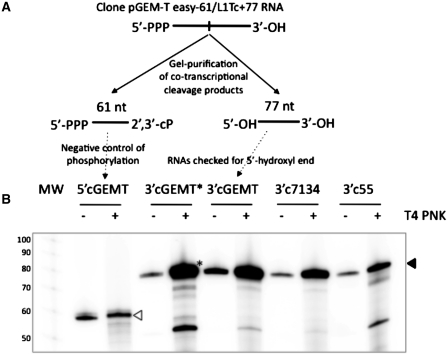Figure 3.
Analysis of the 5′-hydroxyl nature of the ends of the cleavage 3′-products. Schematic cleavage reaction of the clone pGEM-T easy −61/L1Tc+77 RNA is represented in (A). The uncleaved RNA is expected to have 5′-triphosphate and 3′-hydroxyl ends. The cleavage 5′- and 3′-products are expected to have 2′,3′-cyclic phosphate and 5′-hydroxyl ends, respectively. The T4 polynucleotide kinase (T4 PNK) challenge is represented in (B). 5′-hydroxyl ends, not 5′-phosphate, are sensible to phosphorylation by T4 PNK. Same quantity of endogenously radiolabeled cleavage fragments was both ice preserved in reaction buffer and phosphorylated by T4 PNK using gamma 32P-ATP as phosphate donor. The cleavage 3′-products of clones 7134, 55 and pGEM-T easy RNAs were further radiolabeled confirming the expected 5′-hydroxyl nature of their 5′-ends (solid arrowhead). The 61 nt in length RNA 5′-product of the cleavage of the pGEM-T easy construct is used as negative control in the phosphorylation reaction (the empty arrow indicates the labeled 5′-product). One of the 3′-products is pre-treated with alkaline phosphatase prior to being treated with T4 PNK. (marked with an asterisk).

